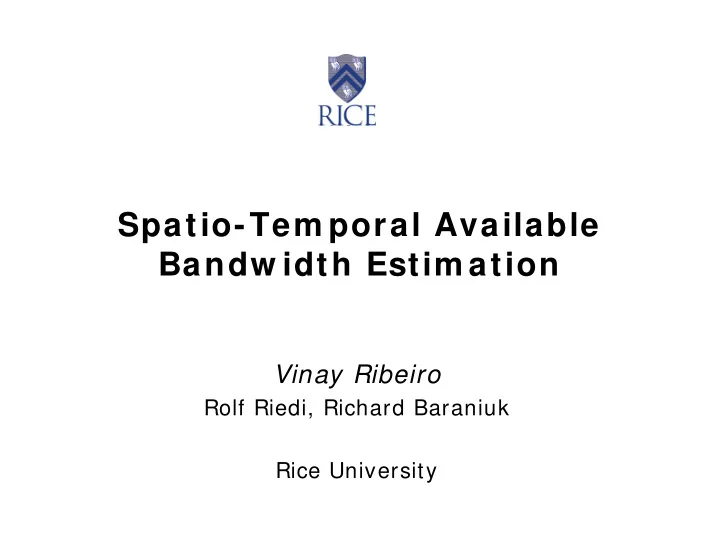

Spatio-Tem poral Available Bandw idth Estim ation Vinay Ribeiro Rolf Riedi, Richard Baraniuk Rice University
Network Path Model • End-to-end paths Packet delay = constant term – Multi-hop (propagation, – No packet reordering service time) + • Router queues variable term – FIFO (queuing delay) – Constant service rate
Key Definitions Path available bandwidth = A min B i i Sub-path available bandwidth = A [ 1 , m ] min B i ≤ ≤ 1 i m Tight link: link with least available bandwidth • Goal : use end-to-end probing to locate tight link in space and over time
Applications • Science: where do Internet tight links occur and why ? • Network aware applications - server selection • Network monitoring - locating hot spots
Methodology = A [ 1 , m ] min B i ≤ ≤ 1 i m • Estimate A[ 1,m] • For m > tight link, A[ 1,m] remains constant
Principle of Self-Induced Congestion • Probing rate = R , path available bandwidth = A R < A � no delay increase R > A � delay increases • Advantages – No topology information required – Robust to multiple bottlenecks
Packet Tailgating • Large packets of size P (TTL= m ) small packets of size p • Large packets exit at hop m • Small packets reach receiver with timing information • Previously employed in capacity estimation
Estimating A[ 1,m] • Key: Probing rate decreases by p/ (p+ P) at link m • Assumption: r< A[ m+ 1,N] , no delay change after link m R < A[ 1,m] � no delay increase R > A[ 1,m] � delay increases
Tight Link Localization • Tight link : link after which A[ 1,m] remains constant • Applicable to any self-induced congestion tool: pathload, pathChirp, IGI, netest etc.
pathChirp • Chirps: exponentially spaced packets • Wide range of probing rates • Efficient: few packets γ = ⇒ 1 . 4 13 packets, 1 - 100Mbps
ns-2 Simulation tight link estimate • Heterogeneous sources • Tight link location changes over time • pathChirp tracks tight link location change accurately
Internet Experiment SLAC � Rice tight link UIUC � Rice tight link • Two paths: UIUC � Rice and SLAC � Rice • Paths share 4 common links • Same tight link estimate for both paths
Comparison with MRTG Data SLAC � Rice UIUC � Rice • A[ 1,m] decreases as expected • Tight link location differs from MRTG data by 1 hop
High Speed Probing • System I/ O limits probing rate • On high speed networks: A > min( B s B , ) � cannot estimate A using d self-induced congestion
Receiver System I/ O Limitation • Treat receiver I/ O bus as an extra link • Use packet tailgating r < B • If then we can estimate A[ 1,N-1] d
Sender System I/ O Limitations • Combine sources to increase net probing rate • Issue: machine synchronization
Conclusions • Towards spatio-temporal available bandwidth estimation • Combine self-induced congestion and packet tailgating • Tight link localization in space and over time • ns-2 and Internet experiments encouraging • Solutions to system I/ O bandwidth limitations spin.rice.edu
Recommend
More recommend